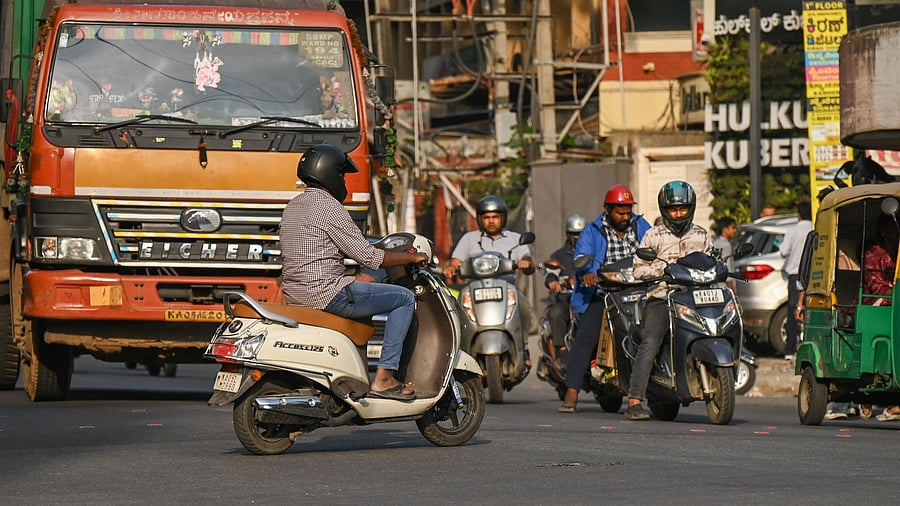
A motorist jumps the signal near Lalbagh West Gate.
Credit: DH Photos/S K Dinesh
Bengaluru: Motorists in Bengaluru continue to commit similar violations in large numbers — around 75 per cent of them related to road safety — according to data since 2022, highlighting the dire need for better traffic awareness and enforcement.
Between January and April 2025, Bengaluru Traffic Police (BTP) issued as many as 20 lakh challans to vehicle users for various violations, with an average of 16,100 cases every day. Around 74 per cent of these violations had to do with people not adhering to key safety rules — two-wheeler riders and pillion riders without a helmet (more than 9.8 lakh cases), drivers not wearing a seatbelt (around 2.5 lakh cases), and jumping traffic signals (around 2 lakh cases) that were detected via contactless means.
A closer look at the data of the last three years indicates that the major violations identified since 2022 have been the same: Riding without a helmet (rider and/or pillion), not wearing a seatbelt and jumping signals.
In 2022, out of the one-crore traffic cases booked by the city police, around 72 per cent were related to the above violations. This included as many as 70 lakh cases of two-wheeler riders/pillion riders not wearing a helmet.
In 2023, violation of safety rules accounted for a whopping 81% of the total 90 lakh traffic cases. In the following year the figure was 77% (out of the total 80 lakh cases).
Between January and April 2025, around 74% of the total 20 lakh traffic cases have been related to safety rules. Other major violations included wrong parking and no-entry.
Notably, 88 per cent of all cases booked in the January-April period were contactless, mainly caught through surveillance cameras, including that of the BTP’s Intelligent Traffic Management System (ITMS).
Most of these cases were in the areas falling under the East and South divisions, such as JB Nagar, HAL Old Airport, Bellandur and HSR Layout. Police officers attributed this to the high volume of vehicles passing through these areas.
Prof Ashish Verma, convenor, IISc Sustainable Transportation Lab, said there needs to be a mechanism to assess the effectiveness of the current penalty to identify deterrence effects.
"Along with fining people, there must be a points concept, where some points accumulate to one’s account each time they commit a violation, and once they reach various totals, penalties like revoking or suspending one’s license should be implemented. This works in many countries and can be quite effective here,” he said.
He also suggested the use of clear signboards to inform people that they are being watched at several junctions, as the cameras being invisible could lead people to think they can get away with violations.
Dr Gautham Melur Sukumar, additional professor of Epidemiology, Nimhans, a WHO Collaborating Centre for Injury Prevention and Safety Promotion, said awareness programmes and current enforcement practices are not enough to reduce violations. "Apart from education and enforcement interventions, innovative penalty recovery systems and promotion of standard helmets are the need of the hour to increase compliance."
He cited the example of fatalities on the Bengaluru-Mysuru highway coming down by 40%-50% through strict speed enforcement as a model that can be adopted across the state.
He also suggested mandatory selling of two standard helmets during two-wheeler purchases, regular surveillance of behaviour-related risk factors for road crashes, linking vehicle insurance renewal processes with traffic fine payment completions and automated debit of penalty amounts through UPI as other means to increase deterrence.
"Random annual surveys must be conducted to check the effectiveness of such interventions by key indicators like violations per 10,000 or 1 lakh population or observed vehicles," he said.